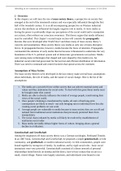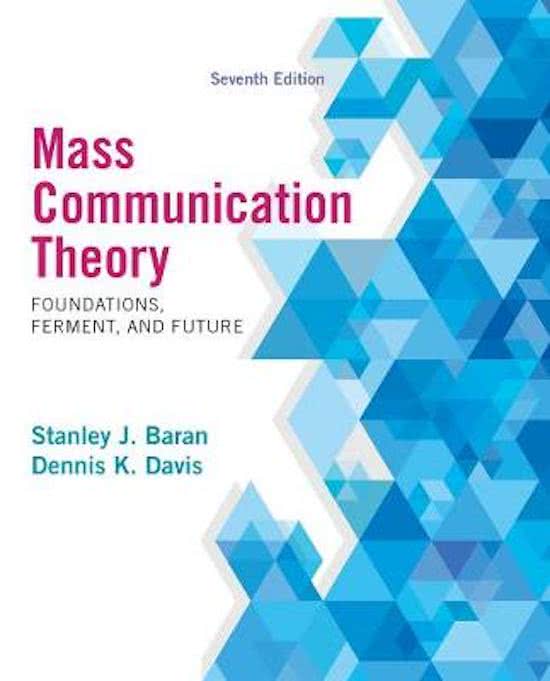Inleiding in de communicatiewetenschap Tentamen 31-10-2016
2 - Overview
In this chapter, we will trace the rise of mass society theory, a perspective on society that
emerged at the end of the nineteenth century and was especially influential through the first
half of the twentieth century. It is an all-encompassing perspective on Western industrial
society that attributes an influential but largely negative role to media. It views media as
having the power to profoundly shape our perceptions of the social world and to manipulate
our actions, often without our conscious awareness. This theory argues that media influence
must be controlled. This chapter’s second major section will consider the propaganda
theories that were developed after World War I and share many of mass society theory’s
concerns and assumptions. Mass society theory saw media as only one of many disruptive
forces. In propaganda theories, however, media became the focus of attention. Propaganda
commanded the attention of early media theorist because it threatened to undermine the very
foundation of the U.S. political system and of democratic governments everywhere. Media
were among many technologies that shaped and were shaped by this modern era. An
industrial social order had great need for the last fast and efficient distribution of information.
There was need to command and control factories that spread across the continent.
Assumptions of Mass Society
The mass society theories were developed in the last century make several basic assumptions
about individuals, the role of media, and the nature of social change. Here is the list of the
assumptions:
1. The media are a powerful force within society that can subvert essential norms and
values and thus undermine the social order. To deal with this great threat media must
be brought under elite control
2. Media are able to directly influence the minds of average people, transforming their
views of the social world.
3. Once people’s thinking is transformed by media, all sorts of bad long-term
consequences are likely to result - not only bringing ruin to individual lives but also
creating social problems on vast scale
4. Average people are vulnerable to media because in mass society they are cut off and
isolated form traditional social institutions that previously protected them from
manipulation.
5. The social chaos initiated by media will likely be resolved by establishment of
totalitarian social order
6. Mass media inevitably debase higher forms of culture, bringing about a general
decline in civilization.
Gemeinschaft and Gesellschaft
Among the originators off mass society theory was a German sociologist, Ferdinand Tönnies.
In an 1887 book, Gemeinschaft und Gesellschaft, he proposed a simple gemeinschaft, or folk
community, and gesellschaft, or modern industrial society. In folk communities, people were
bound together by strong ties of family, by tradition, and by rigid social roles - basic social
institutions were very powerful. Gemeinschafft consisted of a dense network of personal
relationships based heavily on kinship and the direct, face-to-face contact that occurs in a
small, closed village. Norms were largely unwritten, and individuals were bound to one
,Inleiding in de communicatiewetenschap Tentamen 31-10-2016
another in a web of mutual interdependence that touched all aspects of life. Although folk
communities had important strengths as well as serious limitations. Tönnies emphasized the
former. He argued that most people yearn for the order and meaning provided by folk
communities.
In gesellschaft people are bound together by relatively weak social institutions based on
rational choices rather than tradition. Gesellschaft represents ‘the framework of laws and
other formal regulations that characterized large, urban industrial societies. Naturally, it was
the established elites (the traditional wielders of power and the most vocal champions of mass
society theory) who stood to lose the most influence in the move from gemeinschaft to
gesellschaft, as ‘average’ people came to depend les on their influence and more on
formalized and more objectively applied rules and laws. Over the years media have been
continually accused of breaking down folk communities (gemeinschaft) and encouraging the
development of amoral, weak social institutions (gesellschaft).
,Inleiding in de communicatiewetenschap Tentamen 31-10-2016
Mechanical and organic solidarity
In his 1983 Division of Labor in Society, French sociologist Émile Durkheim offered a theory
with the same dichotomy as that of Tönnies, but with a fundamental different interpretation of
modern social orders. Durkheim compared folk communities to machines in which people
were little more than cogs. These machines were very ordered and durable, but people were
forced by a collective consensus to perform traditional social roles. People were bound by
consensus to one another like the parts of a great engine - mechanical solidarity. Durkheim
compared modern social orders to animals rather than to machines. In his theory, people are
like the specialized cells of a body rather than like the cogs of a machine. People perform
specialized tasks and depend on the overall health of the body for their personal survival.
Durkheim used the term organic solidarity to refer to the social ties that bind modern social
orders together.
Mass society in contemporary times
Strengths Weaknesses
1. Speculates about important effects 1. Is unscientific
2. Highlights important structural 2. Is unsystematic
changes and conflicts in modern 3. Is promulgated by elites interested in
cultures persevering power
3. Draws attention to issues of media 4. Underestimates intelligence and
ownership and ethics competence of ‘average’ people
5. Underestimates personal, societal,
and cultural barriers to direct media
influence
Behaviorism
John B. Watson, an animal experimentalist who argued that all human action is merely a
condition response to external environmental stimuli, first popularized stimulus-response
psychology. Watson’s theory became known as behaviorism in recognition of its narrow
focus on isolated human behaviors. Behaviorist argued that the only purpose served by
consciousness was to rationalize behaviors after they are triggered by external stimuli.
Behaviorist argued that most human behavior is the result of conditioning by the external
environment. We are conditioned to act in a certain ways by positive and negative stimuli -
we act to gain rewards or avoid punishments.
Freudianism
Freudianism, on the other hand, was very different form behaviorism, though Sigmund
Freud shared Watson’s skepticism concering people’s ability to exercise effective conscious
or rational control over their actions. Normally one part, the rational mind, or Ego, is in
control, but sometimes other parts become dominant. Freud speculated that human action is
often the product of another, darker side of the self, the Id. This is the egocentric pleasure-
seeking part of ourselves that the Ego must struggle to keep under control. The Ego relies on
an internalized set of cultural rules (the Superego) for guidance. When the Ego loses control
to the Id, hysteria or worse results. When the Superego becomes dominant and the Id is
, Inleiding in de communicatiewetenschap Tentamen 31-10-2016
completely suppressed, people turn into unemotional, depressed social automatons who
simply do what other demand. Propaganda theorists used Freudian notions to develop very
pessimistic interpretations of media influence.
Behaviorism and Freudianism were combined to create propaganda theories that viewed the
average individual as incapable of rational self-control. These theories saw people as highly
vulnerable to media manipulation using propaganda; media stimuli and the Id could trigger
actions that the Ego and the Superego were powerless to stop. Afterwards, the Ego merely
rationalizes actions that it couldn’t control and experiences guilt about them.
Harold Lasswell’s propaganda theory
Lasswell’s theory of propaganda blended ideas borrowed from behaviorism and Freudianism
into a particularity pessimistic vision of media and their role in forging modern social orders
The power of propaganda was not so much the result of the substance or appeal of specific
messages but rather, the result of the vulnerable state of mind of average people. When
average people are confronted daily by powerful threats to their personal lives, they turn to
propaganda for reassurance and a way to overcome the threats.
In Lasswell’s view, democracy has a fatal flaw. It seeks to locate truth and make decisions
through openly conducted debates about issues. Lasswell concluded that even relatively
benign forms of political conflict were inherently pathological. When conflict escalates to the
level it did in Germany during the depression, an entire nation could become psychologically
unbalanced and vulnerable to manipulation. In Lasswell’s view, even routine forms of
political debate could escalate into conflict threatening the social order. Lasswell argued that
propaganda was more than merely using media to lie to people in order to gain temporary
control over them. People need to be slowly prepared to accept radically different ideas and
actions. Communicators need to be need a well-developed long-term campaign strategy in
which new ideas and images are carefully introduced and then cultivated. If these cultivation
strategies are succesfull, they create what Lasswell referred to as master (or collective)
symbols. Master symbols are associated with strong emotions and possess contrast to
behaviorist notions. Lasswell’s theory envisioned a long and quite sophisticated conditioning
process. Exposure to one or two messages would not likely have significant effects.
Lasswell argued that successful social movements gain power by propagating master symbols
over a period of months and years using a variety of media. He believed that past propagation
of most master symbols had been more or less haphazard. Power to control delivery of
propaganda through the mass media would be placed in the hand of a new elite, a scientific
technocracy who would pledge to use its knowledge for good rather than evil, to save
democracy rather than destroy it.
Propaganda theory
Strengths Weaknesses
Is first systematic theory of mass Underestimates abilities of average
communication’ people to evaluate messages






